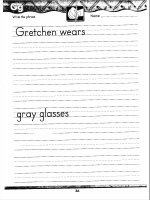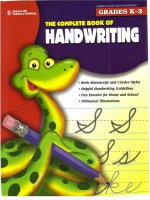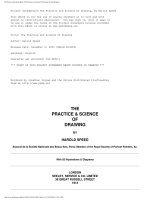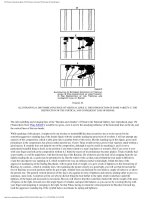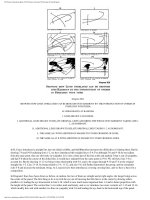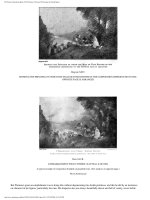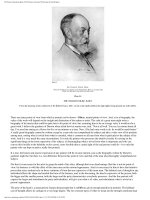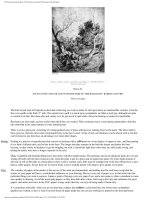The Practice & Science Of Drawing phần 1 pps
Bạn đang xem bản rút gọn của tài liệu. Xem và tải ngay bản đầy đủ của tài liệu tại đây (276.03 KB, 14 trang )
The Project Gutenberg eBook of The Practice & Science Of Drawing, by Harold Speed.
Project Gutenberg's The Practice and Science Of Drawing, by Harold Speed
This eBook is for the use of anyone anywhere at no cost and with
almost no restrictions whatsoever. You may copy it, give it away or
re-use it under the terms of the Project Gutenberg License included
with this eBook or online at www.gutenberg.net
Title: The Practice and Science Of Drawing
Author: Harold Speed
Release Date: December 6, 2004 [EBook #14264]
Language: English
Character set encoding: ISO-8859-1
*** START OF THIS PROJECT GUTENBERG EBOOK SCIENCE OF DRAWING ***
Produced by Jonathan Ingram and the Online Distributed Proofreading
Team at
THE
PRACTICE & SCIENCE
OF
DRAWING
BY
HAROLD SPEED
Associé de la Société Nationale des Beaux-Arts, Paris; Member of the Royal Society of Portrait Painters, &c.
With 93 Illustrations & Diagrams
LONDON
SEELEY, SERVICE & CO. LIMITED
38 GREAT RUSSELL STREET
1913
(1 of 147)3/9/2006 11:03:41 PM
The Project Gutenberg eBook of The Practice & Science Of Drawing, by Harold Speed.
Plate I.
FOUR PHOTOGRAPHS OF SAME MONOCHROME PAINTING IN DIFFERENT STAGES ILLUSTRATING A METHOD OF
STUDYING MASS DRAWING WITH THE BRUSH
PREFACE
Permit me in the first place to anticipate the disappointment of any student who opens this book with the idea of finding "wrinkles"
on how to draw faces, trees, clouds, or what not, short cuts to excellence in drawing, or any of the tricks so popular with the
drawing masters of our grandmothers and still dearly loved by a large number of people. No good can come of such methods, for
there are no short cuts to excellence. But help of a very practical kind it is the aim of the following pages to give; although it may
be necessary to make a greater call upon the intelligence of the student than these Victorian methods attempted.
It was not until some time after having passed through the course of training in two of our chief schools of art that the author got
any idea of what drawing really meant. What was taught was the faithful copying of a series of objects, beginning with the
simplest forms, such as cubes, cones, cylinders, &c. (an excellent system to begin with at present in danger of some neglect), after
which more complicated objects in plaster of Paris were attempted, and finally copies of the human head and figure posed in
suspended animation and supported by blocks, &c. In so far as this was accurately done, all this mechanical training of eye and
hand was excellent; but it was not enough. And when with an eye trained to the closest mechanical accuracy the author visited the
galleries of the Continent and studied the drawings of the old masters, it soon became apparent that either his or their ideas of
drawing were all wrong. Very few drawings could be found sufficiently "like the model" to obtain the prize at either of the great
schools he had attended. Luckily there was just enough modesty left for him to realise that possibly they were in some mysterious
way right and his own training in some way lacking. And so he set to work to try and climb the long uphill road that separates
mechanically accurate drawing from artistically accurate drawing.
v
vi
(2 of 147)3/9/2006 11:03:41 PM
The Project Gutenberg eBook of The Practice & Science Of Drawing, by Harold Speed.
Now this journey should have been commenced much earlier, and perhaps it was due to his own stupidity that it was not; but it
was with a vague idea of saving some students from such wrong-headedness, and possibly straightening out some of the path, that
he accepted the invitation to write this book.
In writing upon any matter of experience, such as art, the possibilities of misunderstanding are enormous, and one shudders to
think of the things that may be put down to one's credit, owing to such misunderstandings. It is like writing about the taste of
sugar, you are only likely to be understood by those who have already experienced the flavour; by those who have not, the wildest
interpretation will be put upon your words. The written word is necessarily confined to the things of the understanding because
only the understanding has written language; whereas art deals with ideas of a different mental texture, which words can only
vaguely suggest. However, there are a large number of people who, although they cannot be said to have experienced in a full
sense any works of art, have undoubtedly the impelling desire which a little direction may lead on to a fuller appreciation. And it is
to such that books on art are useful. So that although this book is primarily addressed to working students, it is hoped that it may
be of interest to that increasing number of people who, tired with the rush and struggle of modern existence, seek refreshment in
artistic things. To many such in this country modern art is still a closed book; its point of view is so different from that of the art
they have been brought up with, that they refuse to have anything to do with it. Whereas, if they only took the trouble to find out
something of the point of view of the modern artist, they would discover new beauties they little suspected.
If anybody looks at a picture by Claude Monet from the point of view of a Raphael, he will see nothing but a meaningless jargon
of wild paint-strokes. And if anybody looks at a Raphael from the point of view of a Claude Monet, he will, no doubt, only see
hard, tinny figures in a setting devoid of any of the lovely atmosphere that always envelops form seen in nature. So wide apart are
some of the points of view in painting. In the treatment of form these differences in point of view make for enormous variety in the
work. So that no apology need be made for the large amount of space occupied in the following pages by what is usually dismissed
as mere theory; but what is in reality the first essential of any good practice in drawing. To have a clear idea of what it is you wish
to do, is the first necessity of any successful performance. But our exhibitions are full of works that show how seldom this is the
case in art. Works showing much ingenuity and ability, but no artistic brains; pictures that are little more than school studies,
exercises in the representation of carefully or carelessly arranged objects, but cold to any artistic intention.
At this time particularly some principles, and a clear intellectual understanding of what it is you are trying to do, are needed. We
have no set traditions to guide us. The times when the student accepted the style and traditions of his master and blindly followed
them until he found himself, are gone. Such conditions belonged to an age when intercommunication was difficult, and when the
artistic horizon was restricted to a single town or province. Science has altered all that, and we may regret the loss of local colour
and singleness of aim this growth of art in separate compartments produced; but it is unlikely that such conditions will occur again.
Quick means of transit and cheap methods of reproduction have brought the art of the whole world to our doors. Where formerly
the artistic food at the disposal of the student was restricted to the few pictures in his vicinity and some prints of others, now there
is scarcely a picture of note in the world that is not known to the average student, either from personal inspection at our museums
and loan exhibitions, or from excellent photographic reproductions. Not only European art, but the art of the East, China and
Japan, is part of the formative influence by which he is surrounded; not to mention the modern science of light and colour that has
had such an influence on technique. It is no wonder that a period of artistic indigestion is upon us. Hence the student has need of
sound principles and a clear understanding of the science of his art, if he would select from this mass of material those things
which answer to his own inner need for artistic expression.
The position of art to-day is like that of a river where many tributaries meeting at one point, suddenly turn the steady flow to
turbulence, the many streams jostling each other and the different currents pulling hither and thither. After a time these newly-met
forces will adjust themselves to the altered condition, and a larger, finer stream be the result. Something analogous to this would
seem to be happening in art at the present time, when all nations and all schools are acting and reacting upon each other, and art is
losing its national characteristics. The hope of the future is that a larger and deeper art, answering to the altered conditions of
humanity, will result.
There are those who would leave this scene of struggling influences and away up on some bare primitive mountain-top start a new
stream, begin all over again. But however necessary it may be to give the primitive mountain waters that were the start of all the
streams a more prominent place in the new flow onwards, it is unlikely that much can come of any attempt to leave the turbulent
waters, go backwards, and start again; they can only flow onwards. To speak more plainly, the complexity of modern art
influences may make it necessary to call attention to the primitive principles of expression that should never be lost sight of in any
work, but hardly justifies the attitude of those anarchists in art who would flout the heritage of culture we possess and attempt a
new start. Such attempts however when sincere are interesting and may be productive of some new vitality, adding to the weight
of the main stream. But it must be along the main stream, along lines in harmony with tradition that the chief advance must be
looked for.
Although it has been felt necessary to devote much space to an attempt to find principles that may be said to be at the basis of the
art of all nations, the executive side of the question has not been neglected. And it is hoped that the logical method for the study of
drawing from the two opposite points of view of line and mass here advocated may be useful, and help students to avoid some of
the confusion that results from attempting simultaneously the study of these different qualities of form expression.
vii
viii
ix
x
(3 of 147)3/9/2006 11:03:41 PM
The Project Gutenberg eBook of The Practice & Science Of Drawing, by Harold Speed.
CONTENTS
I.
INTRODUCTION
II.
DRAWING
III.
VISION
IV.
LINE DRAWING
V.
MASS DRAWING
VI.
THE ACADEMIC AND CONVENTIONAL
VII.
THE STUDY OF DRAWING
VIII.
LINE DRAWING: PRACTICAL
IX.
MASS DRAWING: PRACTICAL
X.
RHYTHM
XI.
RHYTHM: VARIETY OF LINE
XII.
RHYTHM: UNITY OF LINE
XIII.
RHYTHM: VARIETY OF MASS
XIV.
RHYTHM: UNITY OF MASS
XV.
RHYTHM: BALANCE
XVI.
RHYTHM: PROPORTION
XVII.
PORTRAIT DRAWING
XVIII.
THE VISUAL MEMORY
XIX.
PROCEDURE
XX.
MATERIALS
XXI.
CONCLUSION
APPENDIX
INDEX
LIST OF PLATES
I.
SET OF FOUR PHOTOGRAPHS OF THE SAME STUDY FROM THE LIFE IN DIFFERENT STAGES
II.
DRAWING BY LEONARDO DA VINCI
III.
STUDY FOR "APRIL"
IV.
STUDY FOR THE FIGURE OF "BOREAS"
V.
FROM A STUDY BY BOTTICELLI
VI.
STUDY BY ALFRED STEPHENS
VII.
STUDY FOR THE FIGURE OF APOLLO
VIII.
STUDY FOR A PICTURE
xi
xii
(4 of 147)3/9/2006 11:03:41 PM
The Project Gutenberg eBook of The Practice & Science Of Drawing, by Harold Speed.
IX.
STUDY BY WATTEAU
X.
EXAMPLE OF XVTH CENTURY CHINESE WORK
XI.
LOS MENENAS. BY VELAZQUEZ
XII.
STUDY ATTRIBUTED TO MICHAEL ANGELO
XIII.
STUDY BY DEGAS
XIV.
DRAWING BY ERNEST COLE
XV.
FROM A PENCIL DRAWING BY INGRES
XVI.
STUDY BY RUBENS
XVII.
A DEMONSTRATION DRAWING AT THE GOLDSMITHS' COLLEGE
XVIII.
STUDY ILLUSTRATING METHOD OF DRAWING
XIX.
ILLUSTRATING CURVED LINES
XX.
STUDY FOR THE FIGURE OF "LOVE"
XXI.
STUDY ILLUSTRATING TREATMENT OF HAIR
XXII.
STUDY FOR DECORATION AT AMIENS
XXIII.
DIFFERENT STAGES OF THE PAINTING FROM A CAST (1)
XXIII.
DIFFERENT STAGES OF THE PAINTING FROM A CAST (2)
XXIV.
DIFFERENT STAGES OF THE PAINTING FROM A CAST (3)
XXIV.
DIFFERENT STAGES OF THE PAINTING FROM A CAST (4)
XXV.
ILLUSTRATING SOME TYPICAL BRUSH STROKES
XXVI.
DIFFERENT STAGES OF THE SAME STUDY (1)
XXVII.
DIFFERENT STAGES OF THE SAME STUDY (2)
XXVIII.
DIFFERENT STAGES OF THE SAME STUDY (3)
XXIX.
DIFFERENT STAGES OF THE SAME STUDY (4)
XXX.
A STUDY FOR A PICTURE OF "ROSALIND AND ORLANDO"
XXXI.
ILLUSTRATIONS FROM BLAKE'S "JOB" (PLATES I., V., X., XXI.)
XXXII.
ILLUSTRATIONS FROM BLAKE'S "JOB" (PLATES II., XI., XVIII., XIV.)
XXXIII.
FÊTE CHAMPÊTRE
XXXIV.
BACCHUS AND ARIADNE
XXXV.
LOVE AND DEATH
XXXVI.
SURRENDER OF BREDA
XXXVII.
THE BIRTH OF VENUS
XXXVIII.
THE RAPE OF EUROPA
XXXIX.
BATTLE OF S. EGIDIO
XL.
THE ASCENSION OF CHRIST
XLI.
THE BAPTISM OF CHRIST
XLII.
PORTRAIT OF THE ARTIST'S DAUGHTER
XLIII.
MONTE SOLARO, CAPRI
XLIV.
PART OF THE "SURRENDER OF BREDA"
xiii
xiv
(5 of 147)3/9/2006 11:03:41 PM
The Project Gutenberg eBook of The Practice & Science Of Drawing, by Harold Speed.
XLV.
VENUS, MERCURY, AND CUPID
XLVI.
OLYMPIA
XLVII.
L'EMBARQUEMENT POUR CYTHÈRE
XLVIII.
THE ANSIDEI MADONNA
XLIX.
FINDING OF THE BODY OF ST. MARK
L.
FROM A DRAWING BY HOLBEIN
LI.
SIR CHARLES DILKE
LII.
JOHN REDMOND, M.P.
LIII.
THE LADY AUDLEY
LIV.
STUDY ON BROWN PAPER
LV.
FROM A SILVER POINT DRAWING
LVI.
STUDY FOR TREE IN "THE BOAR HUNT"
LIST OF DIAGRAMS
I.
TYPES OF FIRST DRAWINGS BY CHILDREN
II.
SHOWING WHERE SQUARENESSES MAY BE LOOKED FOR
III.
A DEVICE FOR ENABLING STUDENTS TO OBSERVE APPEARANCES AS A FLAT SUBJECT
IV.
SHOWING THREE PRINCIPLES OF CONSTRUCTION USED IN OBSERVING MASSES, CURVES, AND
POSITION OF POINTS
V.
PLAN OF CONE ILLUSTRATING PRINCIPLES OF LIGHT AND SHADE
VI.
ILLUSTRATING SOME POINTS CONNECTED WITH THE EYES
VII.
EGG AND DART MOULDING
VIII.
ILLUSTRATING VARIETY IN SYMMETRY
IX.
ILLUSTRATING VARIETY IN SYMMETRY
X.
ILLUSTRATING INFLUENCE OF HORIZONTAL LINES
XI.
ILLUSTRATING INFLUENCE OF VERTICAL LINES
XII.
ILLUSTRATING INFLUENCE OF THE RIGHT ANGLE
XIII.
LOVE AND DEATH
XIV.
ILLUSTRATING POWER OF CURVED LINES
XV.
THE BIRTH OF VENUS
XVI.
THE RAPE OF EUROPA
XVII.
BATTLE OF S. EGIDIO
XVIII.
SHOWING HOW LINES UNRELATED CAN BE BROUGHT INTO HARMONY
XIX.
SHOWING HOW LINES UNRELATED CAN BE BROUGHT INTO HARMONY
XX.
THE ARTIST'S DAUGHTER
XXI.
THE INFLUENCE ON THE FACE OF DIFFERENT WAYS OF DOING THE HAIR
XXII.
THE INFLUENCE ON THE FACE OF DIFFERENT WAYS OF DOING THE HAIR
xv
xvi
(6 of 147)3/9/2006 11:03:41 PM
The Project Gutenberg eBook of The Practice & Science Of Drawing, by Harold Speed.
XXIII.
EXAMPLES OF EARLY ITALIAN TREATMENT OF TREES
XXIV.
THE PRINCIPLE OF MASS OR TONE RHYTHM
XXV.
MASS OR TONE RHYTHM IN "ULYSSES DERIDING POLYPHEMUS"
XXVI.
EXAMPLE OF COROT'S SYSTEM OF MASS RHYTHM
XXVII.
ILLUSTRATING HOW INTEREST MAY BALANCE MASS
XXVIII.
PROPORTION
THE PRACTICE AND SCIENCE OF DRAWING
I
INTRODUCTION
The best things in an artist's work are so much a matter of intuition, that there is much to be said for the point of view that would
altogether discourage intellectual inquiry into artistic phenomena on the part of the artist. Intuitions are shy things and apt to
disappear if looked into too closely. And there is undoubtedly a danger that too much knowledge and training may supplant the
natural intuitive feeling of a student, leaving only a cold knowledge of the means of expression in its place. For the artist, if he has
the right stuff in him, has a consciousness, in doing his best work, of something, as Ruskin has said, "not in him but through him."
He has been, as it were, but the agent through which it has found expression.
Talent can be described as "that which we have," and Genius as "that which has us." Now, although we may have little control
over this power that "has us," and although it may be as well to abandon oneself unreservedly to its influence, there can be little
doubt as to its being the business of the artist to see to it that his talent be so developed, that he may prove a fit instrument for the
expression of whatever it may be given him to express; while it must be left to his individual temperament to decide how far it is
advisable to pursue any intellectual analysis of the elusive things that are the true matter of art.
Provided the student realises this, and that art training can only deal with the perfecting of a means of expression and that the real
matter of art lies above this and is beyond the scope of teaching, he cannot have too much of it. For although he must ever be a
child before the influence that moves him, if it is not with the knowledge of the grown man that he takes off his coat and
approaches the craft of painting or drawing, he will be poorly equipped to make them a means of conveying to others in adequate
form the things he may wish to express. Great things are only done in art when the creative instinct of the artist has a well-
organised executive faculty at its disposal.
Of the two divisions into which the technical study of painting can be divided, namely Form and Colour, we are concerned in this
book with Form alone. But before proceeding to our immediate subject something should be said as to the nature of art generally,
not with the ambition of arriving at any final result in a short chapter, but merely in order to give an idea of the point of view from
which the following pages are written, so that misunderstandings may be avoided.
The variety of definitions that exist justifies some inquiry. The following are a few that come to mind:
"Art is nature expressed through a personality."
But what of architecture? Or music? Then there is Morris's
"Art is the expression of pleasure in work."
But this does not apply to music and poetry. Andrew Lang's
"Everything which we distinguish from nature"
seems too broad to catch hold of, while Tolstoy's
"An action by means of which one man, having experienced a feeling, intentionally transmits it to others"
17
18
19
(7 of 147)3/9/2006 11:03:41 PM
The Project Gutenberg eBook of The Practice & Science Of Drawing, by Harold Speed.
is nearer the truth, and covers all the arts, but seems, from its omitting any mention of rhythm, very inadequate.
Now the facts of life are conveyed by our senses to the consciousness within us, and stimulate the world of thought and feeling
that constitutes our real life. Thought and feeling are very intimately connected, few of our mental perceptions, particularly when
they first dawn upon us, being unaccompanied by some feeling. But there is this general division to be made, on one extreme of
which is what we call pure intellect, and on the other pure feeling or emotion. The arts, I take it, are a means of giving expression
to the emotional side of this mental activity, intimately related as it often is to the more purely intellectual side. The more sensual
side of this feeling is perhaps its lowest, while the feelings associated with the intelligence, the little sensitivenesses of perception
that escape pure intellect, are possibly its noblest experiences.
Pure intellect seeks to construct from the facts brought to our consciousness by the senses, an accurately measured world of
phenomena, uncoloured by the human equation in each of us. It seeks to create a point of view outside the human standpoint, one
more stable and accurate, unaffected by the ever-changing current of human life. It therefore invents mechanical instruments to do
the measuring of our sense perceptions, as their records are more accurate than human observation unaided.
But while in science observation is made much more effective by the use of mechanical instruments in registering facts, the facts
with which art deals, being those of feeling, can only be recorded by the feeling instrument—man, and are entirely missed by any
mechanically devised substitutes.
The artistic intelligence is not interested in things from this standpoint of mechanical accuracy, but in the effect of observation on
the living consciousness—the sentient individual in each of us. The same fact accurately portrayed by a number of artistic
intelligences should be different in each case, whereas the same fact accurately expressed by a number of scientific intelligences
should be the same.
But besides the feelings connected with a wide range of experience, each art has certain emotions belonging to the particular sense
perceptions connected with it. That is to say, there are some that only music can convey: those connected with sound; others that
only painting, sculpture, or architecture can convey: those connected with the form and colour that they severally deal with.
In abstract form and colour—that is, form and colour unconnected with natural appearances—there is an emotional power, such as
there is in music, the sounds of which have no direct connection with anything in nature, but only with that mysterious sense we
have, the sense of Harmony, Beauty, or Rhythm (all three but different aspects of the same thing).
This inner sense is a very remarkable fact, and will be found to some extent in all, certainly all civilised, races. And when the art of
a remote people like the Chinese and Japanese is understood, our senses of harmony are found to be wonderfully in agreement.
Despite the fact that their art has developed on lines widely different from our own, none the less, when the surprise at its newness
has worn off and we begin to understand it, we find it conforms to very much the same sense of harmony.
But apart from the feelings connected directly with the means of expression, there appears to be much in common between all the
arts in their most profound expression; there seems to be a common centre in our inner life that they all appeal to. Possibly at this
centre are the great primitive emotions common to all men. The religious group, the deep awe and reverence men feel when
contemplating the great mystery of the Universe and their own littleness in the face of its vastness—the desire to correspond and
develop relationship with the something outside themselves that is felt to be behind and through all things. Then there are those
connected with the joy of life, the throbbing of the great life spirit, the gladness of being, the desire of the sexes; and also those
connected with the sadness and mystery of death and decay, &c.
The technical side of an art is, however, not concerned with these deeper motives but with the things of sense through which they
find expression; in the case of painting, the visible universe.
The artist is capable of being stimulated to artistic expression by all things seen, no matter what; to him nothing comes amiss.
Great pictures have been made of beautiful people in beautiful clothes and of squalid people in ugly clothes, of beautiful
architectural buildings and the ugly hovels of the poor. And the same painter who painted the Alps painted the Great Western
Railway.
The visible world is to the artist, as it were, a wonderful garment, at times revealing to him the Beyond, the Inner Truth there is in
all things. He has a consciousness of some correspondence with something the other side of visible things and dimly felt through
them, a "still, small voice" which he is impelled to interpret to man. It is the expression of this all-pervading inner significance that
I think we recognise as beauty, and that prompted Keats to say:
"Beauty is truth, truth beauty."
And hence it is that the love of truth and the love of beauty can exist together in the work of the artist. The search for this inner
20
21
22
(8 of 147)3/9/2006 11:03:41 PM
The Project Gutenberg eBook of The Practice & Science Of Drawing, by Harold Speed.
truth is the search for beauty. People whose vision does not penetrate beyond the narrow limits of the commonplace, and to whom
a cabbage is but a vulgar vegetable, are surprised if they see a beautiful picture painted of one, and say that the artist has idealised
it, meaning that he has consciously altered its appearance on some idealistic formula; whereas he has probably only honestly given
expression to a truer, deeper vision than they had been aware of. The commonplace is not the true, but only the shallow, view of
things.
Plate II.
DRAWING BY LEONARDO DA VINCI FROM THE ROYAL COLLECTION AT WINDSOR
Copyright photo, Braun & Co.
Fromentin's
"Art is the expression of the invisible by means of the visible"
expresses the same idea, and it is this that gives to art its high place among the works of man.
Beautiful things seem to put us in correspondence with a world the harmonies of which are more perfect, and bring a deeper peace
than this imperfect life seems capable of yielding of itself. Our moments of peace are, I think, always associated with some form
of beauty, of this spark of harmony within corresponding with some infinite source without. Like a mariner's compass, we are
restless until we find repose in this one direction. In moments of beauty (for beauty is, strictly speaking, a state of mind rather than
an attribute of certain objects, although certain things have the power of inducing it more than others) we seem to get a glimpse of
this deeper truth behind the things of sense. And who can say but that this sense, dull enough in most of us, is not an echo of a
greater harmony existing somewhere the other side of things, that we dimly feel through them, evasive though it is.
But we must tread lightly in these rarefied regions and get on to more practical concerns. By finding and emphasising in his work
those elements in visual appearances that express these profounder things, the painter is enabled to stimulate the perception of
23
(9 of 147)3/9/2006 11:03:41 PM
The Project Gutenberg eBook of The Practice & Science Of Drawing, by Harold Speed.
them in others.
In the representation of a fine mountain, for instance, there are, besides all its rhythmic beauty of form and colour, associations
touching deeper chords in our natures—associations connected with its size, age, and permanence, &c.; at any rate we have more
feelings than form and colour of themselves are capable of arousing. And these things must be felt by the painter, and his picture
painted under the influence of these feelings, if he is instinctively to select those elements of form and colour that convey them.
Such deeper feelings are far too intimately associated even with the finer beauties of mere form and colour for the painter to be
able to neglect them; no amount of technical knowledge will take the place of feeling, or direct the painter so surely in his
selection of what is fine.
There are those who would say, "This is all very well, but the painter's concern is with form and colour and paint, and nothing else.
If he paints the mountain faithfully from that point of view, it will suggest all these other associations to those who want them."
And others who would say that the form and colour of appearances are only to be used as a language to give expression to the
feelings common to all men. "Art for art's sake" and "Art for subject's sake." There are these two extreme positions to consider,
and it will depend on the individual on which side his work lies. His interest will be more on the aesthetic side, in the feelings
directly concerned with form and colour; or on the side of the mental associations connected with appearances, according to his
temperament. But neither position can neglect the other without fatal loss. The picture of form and colour will never be able to
escape the associations connected with visual things, neither will the picture all for subject be able to get away from its form and
colour. And it is wrong to say "If he paints the mountain faithfully from the form and colour point of view it will suggest all those
other associations to those who want them," unless, as is possible with a simple-minded painter, he be unconsciously moved by
deeper feelings, and impelled to select the significant things while only conscious of his paint. But the chances are that his picture
will convey the things he was thinking about, and, in consequence, instead of impressing us with the grandeur of the mountain,
will say something very like "See what a clever painter I am!" Unless the artist has painted his picture under the influence of the
deeper feelings the scene was capable of producing, it is not likely anybody will be so impressed when they look at his work.
And the painter deeply moved with high ideals as to subject matter, who neglects the form and colour through which he is
expressing them, will find that his work has failed to be convincing. The immaterial can only be expressed through the material in
art, and the painted symbols of the picture must be very perfect if subtle and elusive meanings are to be conveyed. If he cannot
paint the commonplace aspect of our mountain, how can he expect to paint any expression of the deeper things in it? The fact is,
both positions are incomplete. In all good art the matter expressed and the manner of its expression are so intimate as to have
become one. The deeper associations connected with the mountain are only matters for art in so far as they affect its appearance
and take shape as form and colour in the mind of the artist, informing the whole process of the painting, even to the brush strokes.
As in a good poem, it is impossible to consider the poetic idea apart from the words that express it: they are fired together at its
creation.
Now an expression by means of one of our different sense perceptions does not constitute art, or the boy shouting at the top of his
voice, giving expression to his delight in life but making a horrible noise, would be an artist. If his expression is to be adequate to
convey his feeling to others, there must be some arrangement. The expression must be ordered, rhythmic, or whatever word most
fitly conveys the idea of those powers, conscious or unconscious, that select and arrange the sensuous material of art, so as to
make the most telling impression, by bringing it into relation with our innate sense of harmony. If we can find a rough definition
that will include all the arts, it will help us to see in what direction lie those things in painting that make it an art. The not
uncommon idea, that painting is "the production by means of colours of more or less perfect representations of natural objects"
will not do. And it is devoutly to be hoped that science will perfect a method of colour photography finally to dispel this illusion.
What, then, will serve as a working definition? There must be something about feeling, the expression of that individuality the
secret of which everyone carries in himself; the expression of that ego that perceives and is moved by the phenomena of life
around us. And, on the other hand, something about the ordering of its expression.
But who knows of words that can convey a just idea of such subtle matter? If one says "Art is the rhythmic expression of Life, or
emotional consciousness, or feeling," all are inadequate. Perhaps the "rhythmic expression of life" would be the more perfect
definition. But the word "life" is so much more associated with eating and drinking in the popular mind, than with the spirit or
force or whatever you care to call it, that exists behind consciousness and is the animating factor of our whole being, that it will
hardly serve a useful purpose. So that, perhaps, for a rough, practical definition that will at least point away from the mechanical
performances that so often pass for art, "the Rhythmic expression of Feeling" will do: for by Rhythm is meant that ordering of
the materials of art (form and colour, in the case of painting) so as to bring them into relationship with our innate sense of harmony
which gives them their expressive power. Without this relationship we have no direct means of making the sensuous material of
art awaken an answering echo in others. The boy shouting at the top of his voice, making a horrible noise, was not an artist
because his expression was inadequate—was not related to the underlying sense of harmony that would have given it expressive
power.
24
25
26
27
(10 of 147)3/9/2006 11:03:41 PM
The Project Gutenberg eBook of The Practice & Science Of Drawing, by Harold Speed.
Plate III.
STUDY FOR "APRIL"
In red chalk on toned paper.
Let us test this definition with some simple cases. Here is a savage, shouting and flinging his arms and legs about in wild delight;
he is not an artist, although he may be moved by life and feeling. But let this shouting be done on some ordered plan, to a rhythm
expressive of joy and delight, and his leg and arm movements governed by it also, and he has become an artist, and singing and
dancing (possibly the oldest of the arts) will result.
Or take the case of one who has been deeply moved by something he has seen, say a man killed by a wild beast, which he wishes
to tell his friends. If he just explains the facts as he saw them, making no effort to order his words so as to make the most telling
impression upon his hearers and convey to them something of the feelings that are stirring in him, if he merely does this, he is not
an artist, although the recital of such a terrible incident may be moving. But the moment he arranges his words so as to convey in a
telling manner not only the plain facts, but the horrible feelings he experienced at the sight, he has become an artist. And if he
further orders his words to a rhythmic beat, a beat in sympathy with his subject, he has become still more artistic, and a primitive
form of poetry will result.
Or in building a hut, so long as a man is interested solely in the utilitarian side of the matter, as are so many builders to-day, and
just puts up walls as he needs protection from wild beasts, and a roof to keep out the rain, he is not yet an artist. But the moment he
begins to consider his work with some feeling, and arranges the relative sizes of his walls and roof so that they answer to some
sense he has for beautiful proportion, he has become an artist, and his hut has some architectural pretensions. Now if his hut is of
wood, and he paints it to protect it from the elements, nothing necessarily artistic has been done. But if he selects colours that give
him pleasure in their arrangement, and if the forms his colour masses assume are designed with some personal feeling, he has
invented a primitive form of decoration.
And likewise the savage who, wishing to illustrate his description of a strange animal he has seen, takes a piece of burnt wood and
draws on the wall his idea of what it looked like, a sort of catalogue of its appearance in its details, he is not necessarily an artist. It
is only when he draws under the influence of some feeling, of some pleasure he felt in the appearance of the animal, that he
becomes an artist.
28
(11 of 147)3/9/2006 11:03:41 PM
The Project Gutenberg eBook of The Practice & Science Of Drawing, by Harold Speed.
Of course in each case it is assumed that the men have the power to be moved by these things, and whether they are good or poor
artists will depend on the quality of their feeling and the fitness of its expression.
Plate IV.
STUDY ON TISSUE-PAPER IN RED CHALK FOR FIGURE OF BOREAS
The purest form of this "rhythmic expression of feeling" is music. And as Walter Pater shows us in his essay on "The School of
Giorgione," "music is the type of art." The others are more artistic as they approach its conditions. Poetry, the most musical form
of literature, is its most artistic form. And in the greatest pictures form, colour, and idea are united to thrill us with harmonies
analogous to music.
The painter expresses his feelings through the representation of the visible world of Nature, and through the representation of those
combinations of form and colour inspired in his imagination, that were all originally derived from visible nature. If he fails from
lack of skill to make his representation convincing to reasonable people, no matter how sublime has been his artistic intention, he
will probably have landed in the ridiculous. And yet, so great is the power of direction exercised by the emotions on the artist
that it is seldom his work fails to convey something, when genuine feeling has been the motive. On the other hand, the painter
with no artistic impulse who makes a laboriously commonplace picture of some ordinary or pretentious subject, has equally failed
as an artist, however much the skilfulness of his representations may gain him reputation with the unthinking.
The study, therefore, of the representation of visible nature and of the powers of expression possessed by form and colour is
the object of the painter's training.
And a command over this power of representation and expression is absolutely necessary if he is to be capable of doing anything
worthy of his art.
This is all in art that one can attempt to teach. The emotional side is beyond the scope of teaching. You cannot teach people how to
feel. All you can do is to surround them with the conditions calculated to stimulate any natural feeling they may possess. And this
29
30
(12 of 147)3/9/2006 11:03:41 PM
The Project Gutenberg eBook of The Practice & Science Of Drawing, by Harold Speed.
is done by familiarising students with the best works of art and nature.
It is surprising how few art students have any idea of what it is that constitutes art. They are impelled, it is to be assumed, by a
natural desire to express themselves by painting, and, if their intuitive ability is strong enough, it perhaps matters little whether
they know or not. But to the larger number who are not so violently impelled, it is highly essential that they have some better idea
of art than that it consists in setting down your canvas before nature and copying it.
Inadequate as this imperfect treatment of a profoundly interesting subject is, it may serve to give some idea of the point of view
from which the following pages are written, and if it also serves to disturb the "copying theory" in the minds of any students and
encourages them to make further inquiry, it will have served a useful purpose.
II
DRAWING
By drawing is here meant the expression of form upon a plane surface.
Art probably owes more to form for its range of expression than to colour. Many of the noblest things it is capable of conveying
are expressed by form more directly than by anything else. And it is interesting to notice how some of the world's greatest artists
have been very restricted in their use of colour, preferring to depend on form for their chief appeal. It is reported that Apelles only
used three colours, black, red, and yellow, and Rembrandt used little else. Drawing, although the first, is also the last, thing the
painter usually studies. There is more in it that can be taught and that repays constant application and effort. Colour would seem to
depend much more on a natural sense and to be less amenable to teaching. A well-trained eye for the appreciation of form is what
every student should set himself to acquire with all the might of which he is capable.
It is not enough in artistic drawing to portray accurately and in cold blood the appearance of objects. To express form one must
first be moved by it. There is in the appearance of all objects, animate and inanimate, what has been called an emotional
significance, a hidden rhythm that is not caught by the accurate, painstaking, but cold artist. The form significance of which we
speak is never found in a mechanical reproduction like a photograph. You are never moved to say when looking at one, "What fine
form."
It is difficult to say in what this quality consists. The emphasis and selection that is unconsciously given in a drawing done directly
under the guidance of strong feeling, are too subtle to be tabulated; they escape analysis. But it is this selection of the significant
and suppression of the non-essential that often gives to a few lines drawn quickly, and having a somewhat remote relation to the
complex appearance of the real object, more vitality and truth than are to be found in a highly-wrought and painstaking drawing,
during the process of which the essential and vital things have been lost sight of in the labour of the work; and the non-essential,
which is usually more obvious, is allowed to creep in and obscure the original impression. Of course, had the finished drawing
been done with the mind centred upon the particular form significance aimed at, and every touch and detail added in tune to this
idea, the comparison might have been different. But it is rarely that good drawings are done this way. Fine things seem only to be
seen in flashes, and the nature that can carry over the impression of one of these moments during the labour of a highly-wrought
drawing is very rare, and belongs to the few great ones of the craft alone.
It is difficult to know why one should be moved by the expression of form; but it appears to have some physical influence over us.
In looking at a fine drawing, say of a strong man, we seem to identify ourselves with it and feel a thrill of its strength in our own
bodies, prompting us to set our teeth, stiffen our frame, and exclaim "That's fine." Or, when looking at the drawing of a beautiful
woman, we are softened by its charm and feel in ourselves something of its sweetness as we exclaim, "How beautiful." The
measure of the feeling in either case will be the extent to which the artist has identified himself with the subject when making the
drawing, and has been impelled to select the expressive elements in the forms.
Art thus enables us to experience life at second hand. The small man may enjoy somewhat of the wider experience of the bigger
man, and be educated to appreciate in time a wider experience for himself. This is the true justification for public picture galleries.
Not so much for the moral influence they exert, of which we have heard so much, but that people may be led through the vision of
the artist to enlarge their experience of life. This enlarging of the experience is true education, and a very different thing from the
memorising of facts that so often passes as such. In a way this may be said to be a moral influence, as a larger mind is less likely to
harbour small meannesses. But this is not the kind of moral influence usually looked for by the many, who rather demand a moral
story told by the picture; a thing not always suitable to artistic expression.
One is always profoundly impressed by the expression of a sense of bulk, vastness, or mass in form. There is a feeling of being
lifted out of one's puny self to something bigger and more stable. It is this splendid feeling of bigness in Michael Angelo's figures
31
32
33
34
(13 of 147)3/9/2006 11:03:41 PM
The Project Gutenberg eBook of The Practice & Science Of Drawing, by Harold Speed.
that is so satisfying. One cannot come away from the contemplation of that wonderful ceiling of his in the Vatican without the
sense of having experienced something of a larger life than one had known before. Never has the dignity of man reached so high
an expression in paint, a height that has been the despair of all who have since tried to follow that lonely master. In landscape also
this expression of largeness is fine: one likes to feel the weight and mass of the ground, the vastness of the sky and sea, the bulk of
a mountain.
On the other hand one is charmed also by the expression of lightness. This may be noted in much of the work of Botticelli and the
Italians of the fifteenth century. Botticelli's figures seldom have any weight; they drift about as if walking on air, giving a
delightful feeling of otherworldliness. The hands of the Madonna that hold the Child might be holding flowers for any sense of
support they express. It is, I think, on this sense of lightness that a great deal of the exquisite charm of Botticelli's drawing depends.
The feathery lightness of clouds and of draperies blown by the wind is always pleasing, and Botticelli nearly always has a light
wind passing through his draperies to give them this sense.
As will be explained later, in connection with academic drawing, it is eminently necessary for the student to train his eye
accurately to observe the forms of things by the most painstaking of drawings. In these school studies feeling need not be
considered, but only a cold accuracy. In the same way a singer trains himself to sing scales, giving every note exactly the same
weight and preserving a most mechanical time throughout, so that every note of his voice may be accurately under his control and
be equal to the subtlest variations he may afterwards want to infuse into it at the dictates of feeling. For how can the draughtsman,
who does not know how to draw accurately the cold, commonplace view of an object, hope to give expression to the subtle
differences presented by the same thing seen under the excitement of strong feeling?
Plate V.
FROM A STUDY BY BOTTICELLI
In the Print Room at the British Museum.
These academic drawings, too, should be as highly finished as hard application can make them, so that the habit of minute visual
expression may be acquired. It will be needed later, when drawing of a finer kind is attempted, and when in the heat of an
emotional stimulus the artist has no time to consider the smaller subtleties of drawing, which by then should have become almost
instinctive with him, leaving his mind free to dwell on the bigger qualities.
35
(14 of 147)3/9/2006 11:03:41 PM


